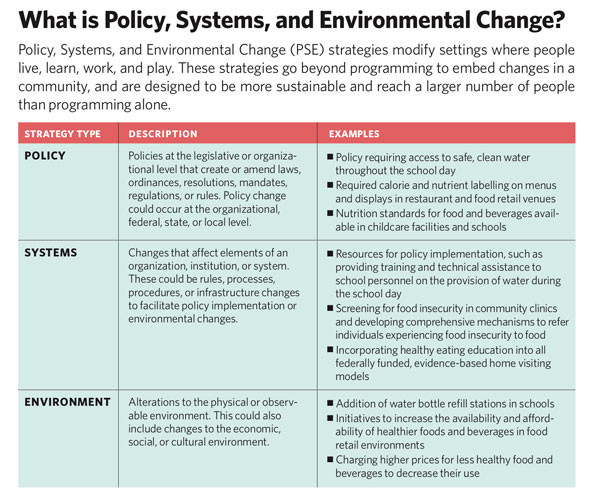 (Illustration by Chiara Zarmati)
(Illustration by Chiara Zarmati)
The most recent national data available on US rates of obesity and diet illustrate that Americans are still not consuming enough fruits, vegetables, dairy, and whole grains, but are eating too many added sugars, saturated fats, and sodium, mostly in the form of sweetened beverages, desserts, and snacks.1 Relatedly, the United States continues to face significant public health problems, with large geographic-, income-, race-, and ethnicity-based disparities in diet quality, overweight and obesity rates, and chronic health conditions.2
Healthy Eating, Active Living

This collection of articles, produced for Grantmakers In Health and supported by the Colorado Health Foundation, explores the latest thinking from health funders, researchers, and advocates on healthy eating and active living (HEAL) and healthy communities.
-
Healthy Eating, Active Living: Reflections, Insights, and Considerations for the Road Ahead
-
Healthy Eating and Active Living Through an Equity Lens
-
Connecting Health and Education So Children Can Learn and Thrive
-
The Future of Healthy Eating Research
-
How to Improve Physical Activity and Health for All Children and Families
-
The Colorado Health Foundation’s HEAL Evolution
-
How Market Forces Could Improve How We Eat
-
The Power of Business to Change Food Culture for the Better
-
Political Power as a Tool to Improve the Health of All Americans
-
Evaluate, Invest in Advocacy, and Shrink the Change
Policies, systems, and environments are significant determinants of children’s dietary intake, weight, and health. Policy, Systems, and Environmental Change (PSE) strategies go beyond education and information programming to embed changes in a community, and they are designed to be more sustainable and reach a larger number of people than programming alone. PSE changes aim to create communities where healthy choices are easy, safe, practical, and affordable for all.
The Importance of PSE Strategies
Although it is important to target individuals for behavior change, it is also imperative that people live in an environment that supports good decisions. According to “The Future of the Public’s Health in the 21st Century,” a 2002 report by the Institute of Medicine, “It is unreasonable to expect that people will change their behavior easily when so many forces in the social, cultural, and physical environment conspire against such change.”
Unfortunately, the food environments that children experience in childcare, schools, restaurants, grocery stores, and other community settings, as well as the widespread marketing of unhealthy foods and beverages, often do not support healthy choices. Inadequate nutrition, poor diet, food insecurity, and obesity are most pronounced in lower-income communities that lack access to healthy foods. Often these households have limited funds to buy—or time to prepare—healthy foods, and they frequently live in neighborhoods surrounded by inexpensive and heavily marketed unhealthy foods and beverages. Until all children in America have access to affordable, healthy foods where they live, learn, and play, efforts to educate children and families on healthy eating will be of limited usefulness.
Along these lines, the 2005 Institute of Medicine report “Preventing Childhood Obesity: Health in the Balance” concludes that environmental and policy influences are potentially the most powerful strategies for addressing childhood obesity. At that time, little was known about the most important food- and diet-related environmental influences that impact children’s eating patterns and weight, or about the most feasible and effective policies for improving children’s food environments. To reduce this knowledge gap, the Robert Wood Johnson Foundation (RWJF), the largest US philanthropic foundation dedicated to improving health for all Americans, launched Healthy Eating Research (HER), a national research program, in 2005.
The Research Program
HER supports research on PSE strategies with strong potential to promote the health and well-being of children at a population level. Specifically, HER aims to help all children receive optimal nutrition and obtain a healthy weight. HER grantmaking focuses on children and adolescents from birth to 18 years old, and their families, giving priority to lower-income and racial and ethnic minority populations that are at risk of poor nutrition and obesity. Findings are expected to advance the field’s efforts to ensure that all children and their families have the opportunity and resources to experience the best physical, social, and emotional health possible and to promote health equity.
Since its inception in 2005, HER has released 18 competitive calls for proposals and awarded more than 200 grants, totaling approximately $25.3 million, focused on the following: improving dietary patterns and feeding practices for infants, toddlers, and young children; improving food environments in schools and after-school, childcare, and preschool settings; increasing healthy food access; agricultural and nutrition policies; food pricing and economic incentives and disincentives; food and beverage marketing and promotion; sugar-sweetened beverages; water access; message framing; and menu labeling.

HER has been a leader in providing evidence in areas where there has previously been little or no research. For instance, HER studies and papers have provided key evidence showing the following:
- Policies to improve school food environments have been implemented without resulting in increased food waste.
- Childcare settings participating in the federal Child and Adult Care Food Program (CACFP) serve healthier foods than nonparticipating settings, but there is room for improvement in nutrition quality in all childcare settings.
- Children and adolescents frequently visit corner stores in close proximity to schools where availability of healthy foods is limited and the most frequently purchased items are energy dense and of low nutrition. But initiatives in communities have begun to demonstrate success in improving the availability of healthy food in these stores.
- Food industry standards for regulating unhealthy food advertising have improved but still have a way to go.
- Current sugar-sweetened beverage taxes are neither large enough nor transparent enough to change behavior without accompanying consumer education, but larger taxes have the potential to improve behavior and weight outcomes.
- While studies of menu labeling have shown limited evidence of changing customers’ purchasing behaviors, they have increased awareness of calorie information.
- PSE strategies to improve healthier food and beverage choices in food retail settings (i.e., grocery stores and restaurants) have largely not been implemented or evaluated.
In addition to making grants, HER launched a new research strategy in 2013 focused on bringing together a panel of national experts and leaders to develop recommendations on timely and relevant topics, and to inform the development of healthy eating and obesity-prevention policies and practices at the local, state, and national levels. To date, HER has convened four panels of national experts to develop comprehensive recommendations regarding age-based definitions of healthier beverages; responsible practices in marketing food to children; minimum stocking levels of healthful food for small retail food stores; and best practices for promoting healthy nutrition and feeding patterns for infants and toddlers. The recommendations have been widely used by several organizations, including Partnership for a Healthier America, 1,000 Days, and Pan American Health Organization, and have been cited frequently by advocates such as the National Alliance for Nutrition and Activity and the American Heart Association during state- or federal-rule-making comment periods. Not all research questions lend themselves well to this format, but the benefits of an expert-panel approach include a multidisciplinary consensus-building process, consolidation and augmentation of existing standards or recommendations, and the opportunity to fill research gaps in a timely manner.
The variety of funding mechanisms that HER offers—competitive calls for proposals, small-scale commissioned studies, rapid-response studies and papers, and expert panels—as well as the methods available for communicating research findings—scientific publications, research reviews, issue briefs, policy briefs, and infographics—has enabled the program to be highly responsive to the needs of advocates, policymakers, and other decision makers, as well as to contribute new scientific knowledge to the field.
HER’s Future
Child obesity remains a critical public health issue. In order to tackle this problem, PSE strategies may need to take a more holistic approach in order to achieve optimal health for children. Our health is shaped by our social conditions and circumstances, including the communities and neighborhoods in which we live, access to education, good jobs with fair pay, housing, quality health care, and social support networks. Many Americans will not achieve good health until systemic barriers—poverty, discrimination, and racism—are dismantled and the social, environmental, and economic conditions of these social determinants of health are improved.3 Moreover, environmental factors influencing child nutrition, diet quality, and food access are often compounded by social and individual factors such as gender, age, race, ethnicity, education level, socioeconomic status, and disability status.
In her 2017 National Academy of Medicine discussion paper, “Getting to Equity in Obesity Prevention,” Shiriki Kumanyika points out that the reported differences in obesity prevalence and trends by racial and ethnic minority groups or those of low socioeconomic status are not chance occurrences. Rather, they reflect certain population groups “whose opportunities and social agency have been systematically and unfairly curtailed to be more exposed to obesity-promoting environmental influences and less able to avoid the associated adverse effects on eating and physical activity.” 4 Thus, Kumanyika argues, we will not be able to tackle the issues of obesity and diet quality equitably without also addressing the social determinants of these issues.
Going forward, HER is broadening its scope to establish a research base on PSE strategies to promote supportive policies and enabling environments for caregivers, families, and communities to foster optimal nutrition, diet quality, and weight. This approach will go beyond the work we have funded in the past to focus on the interaction of social, political, economic, and familial influences and environments on nutrition, healthy eating, and healthy weight.
Ultimately, this work aims to boost healthy eating by providing the evidence needed to promote healthier food environments and establish equitable and supportive policies for caregivers and families. Approaches need to be considered that cut across multiple levels: empowering individuals and families to make healthier choices; creating or adjusting microenvironments where children and families live, learn, work, and play, and building supportive macroenvironments that provide families with adequate economic supports and poverty-reduction strategies. Applying this framework to an early intervention designed to promote diet quality and mitigate obesity risk for new parents and their babies might suggest several different possibilities:
- Educating parents on strategies around what and how to feed their infant in the first year (empowering families)
- Implementing up-to-date nutrition standards and feeding practices in the infant’s childcare setting (enabling microenvironment)
- Improving access to economic supports for the family, such as the Special Supplemental Nutrition Program for Women, Infants, and Children (WIC) or the Supplemental Nutrition Assistance Program (SNAP), so that a family has more money available to spend on healthy food
- Examining a parent’s access to paid family leave or breastfeeding supports in the workplace, which would improve a new parent’s ability to follow through on recommended feeding practices
Poor diet and obesity are health equity issues. In order to achieve health equity—whereby everyone has a fair and just opportunity to be as healthy as possible—we need to apply an equity lens across all levels of influence and PSE strategies. This includes addressing disparities among communities of color, between rural and urban geographic areas, in socioeconomic status, and among other groups of marginalized children and their caregivers. Not all families and communities operate within the same constraints or have access to the same resources. In cases where resources are lacking, this approach requires an intentional examination of how interventions or PSE strategies may need to be adapted and tested, given these new sets of constraints.
The Link Between Research and Policy
Over the years, HER has succeeded in bridging the gap between researchers and key decision makers by identifying a critical research gap, acting on it, and effectively communicating findings to advocates and policymakers. Research conducted and funded by HER continues to inform high-level federal, state, and local policy as well as garner extensive media coverage, and HER’s grantees have been quite successful in using funding from external agencies and publishing their scholarly work in high-profile peer-reviewed journals. Study findings have often led to meaningful improvements in food and nutrition policies, systems, and environments, which we know to be significant determinants of children’s weight and health.
In order to design research studies to address disparities and inequities in healthy eating and weight, and to identify and target the socioeconomic and contextual barriers contributing to these disparities and inequities, there must be a two-way flow of information between policymakers and the research and advocacy communities.5 We hope that this new conceptual framework will help drive demand for research focusing on the social determinants of health related to nutrition and enhance the field’s focus on the interactions of individual, environmental, and social factors that influence a child’s health, diet, and risk for obesity. We also hope that others can build on the lessons learned and approach HER to fund PSE strategies in the United States and globally, and communicate research results to a broad array of audiences to improve healthy eating and weight status among children and adults.
Support SSIR’s coverage of cross-sector solutions to global challenges.
Help us further the reach of innovative ideas. Donate today.
Read more stories by Megan Lott & Mary Story.

